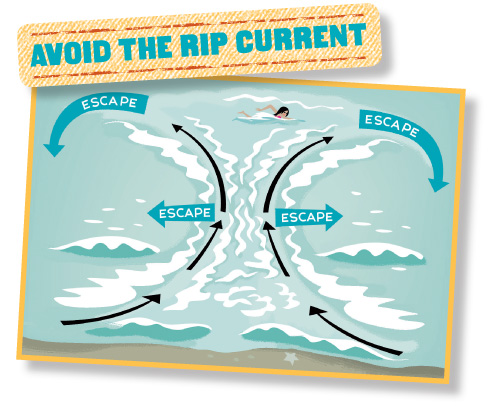One minute you’re frolicking in the sea, the next you’re being sucked away from shore as if a sea monster is slurping you into a straw. You’ve just met a rip current. Rip currents are narrow channels of water flowing rapidly out to sea. Usually, sand slows them down, but if there’s a dip in the sandbar, it’s a fast track off shore.

Current Events
Rip currents, often mistakenly called riptides, can occur in any kind of weather, and on any beach with breaking waves. Weather conditions that are rip-current friendly include very windy days and approaching storms. All beaches—including those of large lakes, such as North America’s Great Lakes—have experienced rip currents.
Escape the Grip of the Rip
The reason rip currents are so deadly is that many people don’t understand how they work. A rip current moves pretty fast—faster than you can swim. When people try to swim against a rip current, it’s like swimming on a treadmill. No matter how hard you swim, you won’t make it any closer to shore. In the end, people wind up too exhausted to swim anymore, and they drown.
Ripped from the Headlines
Rip currents can form at any time, but there are some warning signs that one might be lurking: a streak of muddy water heading out to sea, a rippled stripe of water, or crisscrossed waves can all indicate a possible rip current. Swim where lifeguards are on duty; they will have up-to-date info on the rips.
HOW TO SURVIVE A RIP CURRENT
- Swim sideways. Don’t try to fight the current. You will lose. Instead, swim parallel to the shore until you are out of the current.
- Go with the flow. If you cannot swim out of the current, simply float on your back. Try to save your energy. After 50 to 100 yards (46 to 91 m), the rip current should stop pulling you out to sea.
- On the beach. Even if you are being taken out to sea, stay calm. If there are people on shore, wave your hands and yell. Rip currents occur close enough to shore for someone on the beach to see or hear you, and get help.
- Be an angler. Once you are out of the rip current, swim back to shore at an angle away from the rip current. You certainly don’t want to go through that again.

BE AWARE
• The good news is that rip currents aren’t very big. A typical rip current is less than 100 feet (30.5 m) wide and rarely extends more than 100 yards (91 m) from shore.
